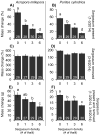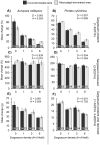Spatial and temporal limits of coral-macroalgal competition: the negative impacts of macroalgal density, proximity, and history of contact
- PMID: 30505047
- PMCID: PMC6261525
- DOI: 10.3354/meps12410
Spatial and temporal limits of coral-macroalgal competition: the negative impacts of macroalgal density, proximity, and history of contact
Abstract
Tropical reefs are commonly transitioning from coral- to macroalgal-dominance, producing abrupt, and often lasting, shifts in community composition and ecosystem function. Although negative effects of macroalgae on corals are well documented, whether such effects vary with spatial scale or the density of macroalgae remains inadequately understood, as does the legacy of their impact on coral growth. Using closely adjacent coral- versus macroalgal-dominated areas, we tested effects of macroalgal competition on the Indo-Pacific corals Acropora millepora and Porites cylindrica. When corals were transplanted to areas of: i) macroalgal-dominance, ii) macroalgal-dominance but with nearby macroalgae removed, or iii) coral-dominance lacking macroalgae, coral growth was equivalently high in plots without macroalgae and low (62-90% less) in plots with macroalgae, regardless of location. In a separate experiment, we raised corals above the benthos in each area and exposed them to differing densities of the dominant macroalga Sargassum polycystum. Coral survivorship was high (≥ 93% after 3 months) and did not differ among treatments, whereas the growth of both coral species decreased as a function of Sargassum density. When Sargassum was removed after two months, there was no legacy effect of macroalgal density on coral growth over the next seven months; however, there was no compensation for previously depressed growth. In sum, macroalgal impacts were density dependent, occurred only if macroalgae were in close contact, and coral growth was resilient to prior macroalgal contact. The temporal and spatial constraints of these interactions suggest that corals may be surprisingly resilient to periodic macroalgal competition, which could have important implications for ecosystem trajectories that lead to reef decline or recovery.
Keywords: Fiji; coral reef; coral-algal competition; macroalgae.
Figures



References
-
- Barott KL, Rohwer FL. Unseen players shape benthic competition on coral reefs. Trends Microbiol. 2012;20:621–628. - PubMed
-
- Birrell CL, McCook LJ, Willis BL, Diaz-Pulido GA. Effects of benthic algae on the replenishment of corals and the implications for the resilience of coral reefs. In: Gibson RN, Atkinson RJA, Gordon JDM, editors. Oceanogr Mar Biol Annu Rev. Vol. 46. 2008. pp. 25–63.
-
- Box SJ, Mumby PJ. Effect of macroalgal competition on growth and survival of juvenile Caribbean corals. Mar Ecol Prog Ser. 2007;342:139–149.
Grants and funding
LinkOut - more resources
Full Text Sources
Research Materials
